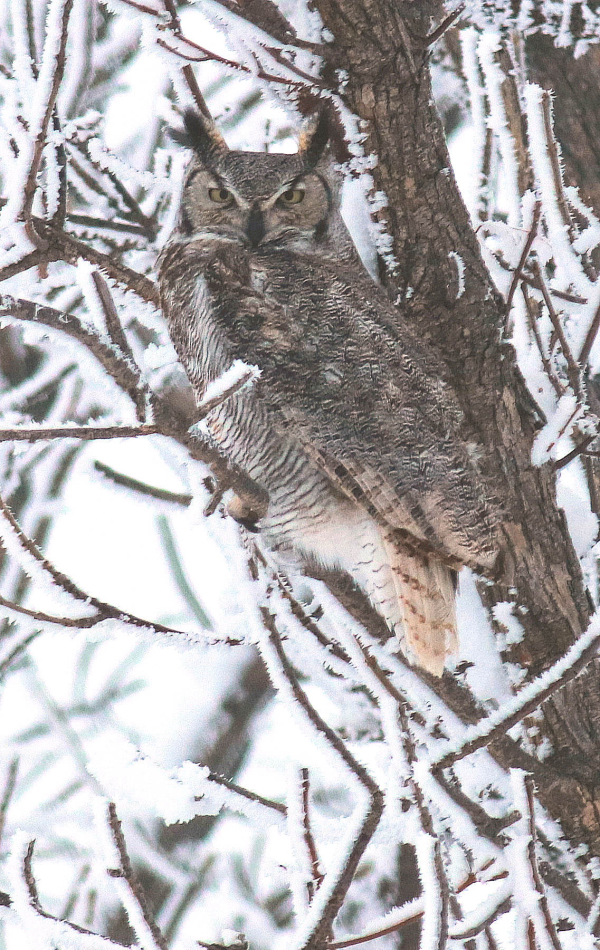
The first of several Great Horned Owls observed last week revealed itself in the midst of a hoar-frost covered grove of trees on a rare day when three were sighted. Note the light color of the owl’s tail feathers, and the thickness of the frost.
Attachments area
|
Friday I found my ninth Great Horned Owl in five days, including three last Tuesday within nine miles of home, two Thursday, and three more Friday. Considering I hadn’t seen a Great Horned Owl for several weeks, that’s quite a change. The other change was that I found no Snowy Owls when I rechecked the Steele area that has produced a Snowy sighting each of the past six times I visited the area. Indicative of a change? Well, it’s a change of months at least – January to February – and that means Great Horned Owls are on the edge of beginning their nesting season along the border of the Dakotas.
I haven’t heard any owls calling, although I haven’t done any nighttime owl surveillance, but I’m sure their behavior is changing, as evidenced by their new practice of perching in high exposed locations at sunset after a winter of hiding during daylight hours – or have they moved into the region during the past week? It’s fun to speculate, but the only thing I can really be assured of is that the first Great Horned Owl eggs will be laid in this area the first week of March and their nesting season will be in full force. Owls don’t build their own nests, so before laying, Great Horned Owls will select a nest – often a nest used by a Red-tailed Hawk the previous season.
Last year, you may recall that I chronicled a Great Horned Owl nesting cycle after a pair took over the only Ferruginous Hawk nest in the area, a nesting attempt that fledged two. Great Horned Owls are very tough on nests, so usually they only use a nest once, then move on. In the case of the old Ferruginous nest, there is little left of it now. (I’m guessing the pair of Ferrugs will return and rebuild it in April, after relocating to a gravel hill ground nest last year.) Of course, Great Horned Owls are already nesting in many parts of the United States, or about to start. So be aware in case you might find an incubating Great Horned Owl in a requisitioned hawk or raven nest near you.
More Birds – Other area birds remain static, consisting of Sharp-tailed Grouse, Ring-necked Pheasants, Horned Larks, and a Bald Eagle. Before my first owl sighting Friday, I noticed a flock of 14 Sharp-tailed Grouse flying low, so was enticed to follow them to a landing zone at the base of a tall snow-covered gravel hill a bit more than a half mile west. As I photographed them, they began climbing the steep hill, with eight grouse eventually standing at the snowy peak, where they could overlook the broad white prairie landscape. Similar to the birds I encounter afield, my feeder birds have remained static with White-breasted Nuthatches, Blue Jays, Downy Woodpeckers, and Hairy Woodpeckers, but I’m imagining that some changes will break the static reception in this area soon.
I’ve worried a bit that during the new year there have not been two sunny days in a row in the Pierre area to the southwest of here. Pierre, of course, is at the center of my SoDak hotspot for wintering raptors, so I’m hoping sunshine will abound in the area soon so I have reason to return as we approach the end of the winter raptor season there. In the meantime, I hope you have a wildly better, more diverse, more abundant avian contingent at your February birding locations – at home, at work, and at your favorite locations to visit afield – Enjoy!
Article and photo by Paul Konrad
Share your bird sightings and photos at editorstbw2@gmail.com